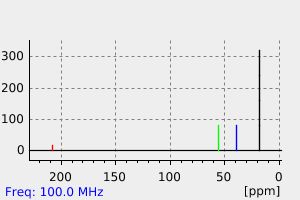1-azido-3-methylbutan-2-one | 76779-97-0
分子结构分类
中文名称
——
中文别名
——
英文名称
1-azido-3-methylbutan-2-one
英文别名
1-Azido-3.3-dimethyl-aceton
CAS
76779-97-0
化学式
C5H9N3O
mdl
——
分子量
127.146
InChiKey
IGJOEYTXYXBXLD-UHFFFAOYSA-N
BEILSTEIN
——
EINECS
——
-
物化性质
-
计算性质
-
ADMET
-
安全信息
-
SDS
-
制备方法与用途
-
上下游信息
-
文献信息
-
表征谱图
-
同类化合物
-
相关功能分类
-
相关结构分类
物化性质
-
保留指数:992
计算性质
-
辛醇/水分配系数(LogP):2.1
-
重原子数:9
-
可旋转键数:3
-
环数:0.0
-
sp3杂化的碳原子比例:0.8
-
拓扑面积:31.4
-
氢给体数:0
-
氢受体数:3
SDS
反应信息
-
作为反应物:描述:1-azido-3-methylbutan-2-one 在 sodium metaborate 、 双氧水 、 三苯基膦 、 三氯氧磷 作用下, 以 溶剂黄146 、 苯 为溶剂, 反应 38.0h, 生成 吡嗪,3-氯-2,5-二(2-甲基丙基)-参考文献:名称:来自鳄鱼粘杆菌和海洋细菌的新型吡嗪摘要:使用 CLSA 或 SPME 顶空方法收集了来自北海的 2 株粘杆菌 Chondromyces crocatus 和 7 株海洋 Alphaproteobacteria 释放的挥发物,并通过 GC-MS 进行分析。在 C. crocatus 的提取物中鉴定出属于不同类别的 27 种吡嗪。2,5-二烷基吡嗪和相关的3-甲氧基-2,5-二烷基吡嗪占主导地位。从天然来源获得了几种吡嗪,如 2-(1-甲基乙烯基)-5-(1-甲基乙基)吡嗪 (7) 和具有甲基、异丙基、异丁基或仲丁基侧链的 3-甲氧基-2,5-二烷基吡嗪首次。鉴定必须依赖合成参考材料,这些参考材料是使用 Furstner 铁催化的氯吡嗪与格氏试剂偶联或叠氮酮缩合获得的关键步骤。合成材料允许鉴定两种以前未知的细菌来源的菠萝甲虫 Carpophilus humeralis 引诱剂,即 3-甲氧基-2-(1-甲基丙基)-5-(2-甲基丙基)吡嗪DOI:10.1002/ejoc.200500280
-
作为产物:描述:2-(trimethylsilyloxy)-3-methyl-1-butene 在 sodium azide 、 溴 作用下, 以 乙醇 、 水 、 溶剂黄146 、 正戊烷 为溶剂, 反应 20.5h, 生成 1-azido-3-methylbutan-2-one参考文献:名称:来自鳄鱼粘杆菌和海洋细菌的新型吡嗪摘要:使用 CLSA 或 SPME 顶空方法收集了来自北海的 2 株粘杆菌 Chondromyces crocatus 和 7 株海洋 Alphaproteobacteria 释放的挥发物,并通过 GC-MS 进行分析。在 C. crocatus 的提取物中鉴定出属于不同类别的 27 种吡嗪。2,5-二烷基吡嗪和相关的3-甲氧基-2,5-二烷基吡嗪占主导地位。从天然来源获得了几种吡嗪,如 2-(1-甲基乙烯基)-5-(1-甲基乙基)吡嗪 (7) 和具有甲基、异丙基、异丁基或仲丁基侧链的 3-甲氧基-2,5-二烷基吡嗪首次。鉴定必须依赖合成参考材料,这些参考材料是使用 Furstner 铁催化的氯吡嗪与格氏试剂偶联或叠氮酮缩合获得的关键步骤。合成材料允许鉴定两种以前未知的细菌来源的菠萝甲虫 Carpophilus humeralis 引诱剂,即 3-甲氧基-2-(1-甲基丙基)-5-(2-甲基丙基)吡嗪DOI:10.1002/ejoc.200500280
文献信息
-
NAKAJIMA M.; LOESCHORN C. A.; CIMBRELO W. E.; ANSELME J.-P., ORG. PREP. AND PROCED. INT., 1980, 12, NO 5, 265-268作者:NAKAJIMA M.、 LOESCHORN C. A.、 CIMBRELO W. E.、 ANSELME J.-P.DOI:——日期:——
表征谱图
-
氢谱1HNMR
-
质谱MS
-
碳谱13CNMR
-
红外IR
-
拉曼Raman
-
峰位数据
-
峰位匹配
-
表征信息
同类化合物
顺式-2-硝基环己基乙酸酯
顺式-2-硝基-6-甲基环己酮
雷尼替丁杂质18
铝硝基甲烷三氯化物
钾离子载体III
重氮(硝基)甲烷
醛基-七聚乙二醇-叠氮
过氧亚甲基
辛腈,4-氟-4-硝基-7-羰基-
辛烷,1,2-二氯-1-硝基-
赤霉素A4+7(GA4:GA7=65:35)
苄哒唑
羟胺-四聚乙二醇-叠氮
羟胺-三乙二醇-叠氮
米索硝唑
磷酸十二醇酯
碘硝基甲烷
碘化e1,1-二甲基-4-羰基-3,5-二(3-苯基-2-亚丙烯基)哌啶正离子
硝酰胺
硝基脲银(I)复合物
硝基甲醇
硝基甲烷-d3
硝基甲烷-13C,d3
硝基甲烷-13C
硝基甲烷-(15)N
硝基甲烷
硝基甲基甲醇胺
硝基环辛烷
硝基环戊烷
硝基环戊基阴离子
硝基环庚烷
硝基环己烷锂盐
硝基环己烷钾盐
硝基环己烷
硝基环丁烷
硝基氨基甲酸
硝基新戊烷
硝基二乙醇胺
硝基乙醛缩二甲醇
硝基乙醛缩二乙醇
硝基乙腈
硝基乙烷-D5
硝基乙烷-1,1-d2
硝基乙烷
硝基乙烯
硝基丙烷
硝基丙二醛(E,E)-二肟
硝基丙二腈
硝基-(3-硝基-[4]吡啶基)-胺
硝乙醛肟







